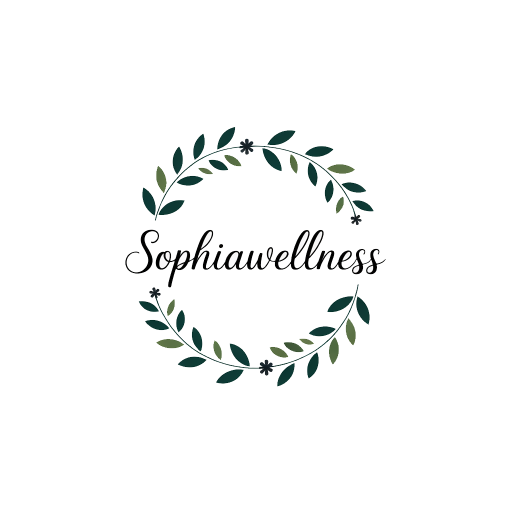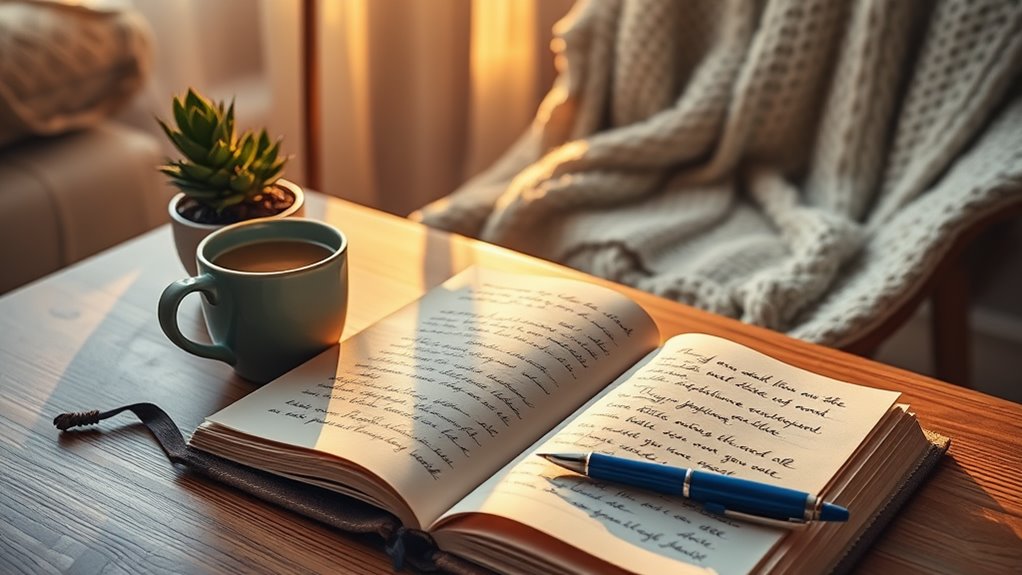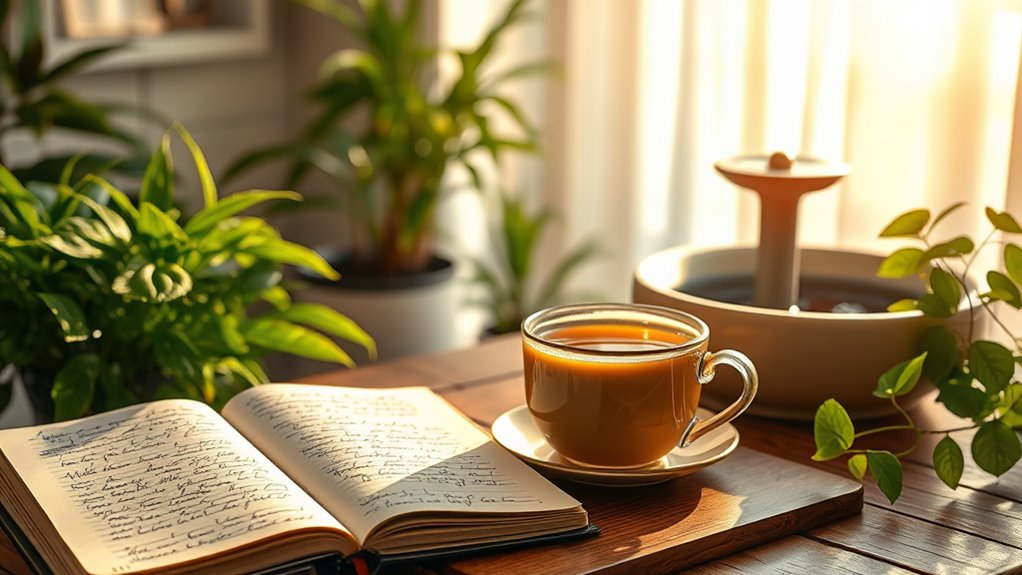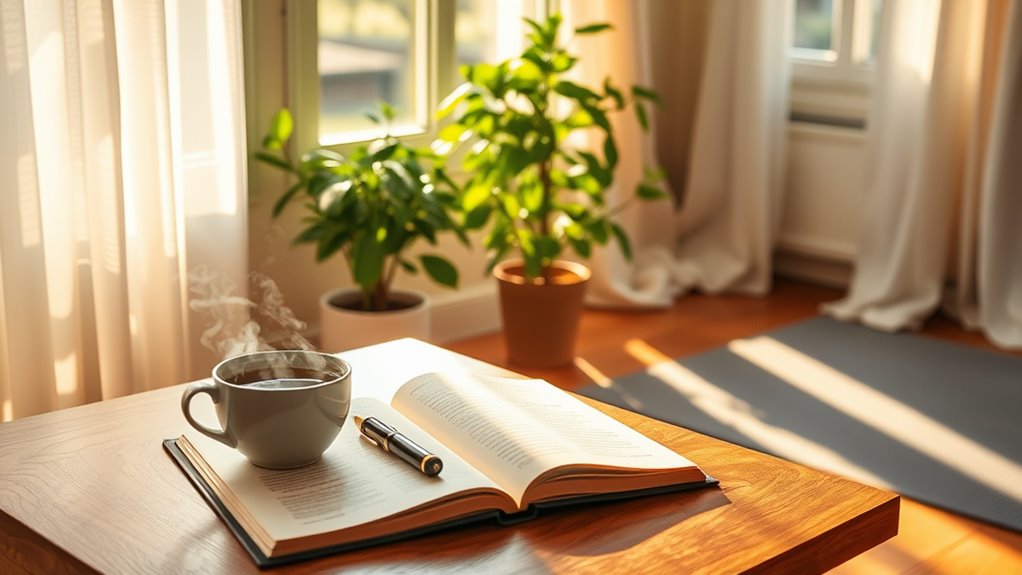How I Used Journaling to Overcome Anxiety (And How You Can Too)
Journaling can transform your battle with anxiety into a path toward self-discovery and healing. By choosing a technique that resonates with you, like freewriting or visual journaling, you can express your emotions and challenge negative thoughts. Setting up a regular routine makes a difference, providing you with a space to reflect on your feelings. As you recognize your progress, you’ll build resilience. There’s so much more to explore about this restorative process that can help you too.
Key Takeaways
- Journaling helped me articulate my fears, providing clarity and understanding of my anxiety triggers and patterns.
- I experimented with different techniques, such as freewriting and gratitude journaling, to discover what worked best for me.
- Establishing a daily routine of 10 to 15 minutes allowed me to consistently track my emotional state and progress.
- Combining art and writing in my journal gave me a creative outlet for expressing my emotions and reducing anxiety.
- Reflecting on past entries helped me recognize my growth and motivated me to continue journaling for mindfulness and emotional balance.
My Journey With Anxiety
When I first realized I was battling anxiety, it felt like a storm brewing inside me, and I struggled to find my footing. It wasn’t just me; nearly 19.1% of U.S. adults face anxiety disorders annually, with women being more affected. In fact, the highest rates of anxiety symptoms are found among adults aged 18-29, with 19.5% experiencing anxiety symptoms. Journaling can be a powerful tool for transforming your life, helping individuals articulate their fears and develop healthier coping mechanisms. I often felt overwhelmed, caught between mild and severe symptoms. To regain control, I turned to affirmations and journaling. Daily affirmations helped reframe my mindset, while journaling became my outlet to dissect thoughts and identify triggers.
Discovering the Power of Journaling
Journaling can be a transformative practice for anyone grappling with anxiety. It offers a powerful space to clarify your thoughts and feelings, enabling you to tackle anxiety head-on.
Here are some benefits you can experience:
- Organize chaotic thoughts and emotions.
- Identify patterns and triggers that heighten your anxiety.
- Improve your mood and overall well-being.
- Challenge and reframe negative thoughts effectively.
- Use it as a complementary tool alongside other treatments. Journaling has been shown to provide potential benefits with low adverse effects (evidence-based guidelines). Additionally, the practice of affirmations can enhance your journaling experience, allowing you to cultivate a more positive mindset.
Choosing the Right Journaling Technique
When it comes to choosing a journaling technique, start by evaluating your personal preferences and what feels comfortable for you. Explore various methods like freewriting or gratitude journaling to see what resonates. Don’t hesitate to experiment with different techniques until you find the one that best helps you manage your anxiety. Regular journaling fosters a logical mindset towards anxiety, allowing you to better process your emotions. Incorporating affirmations and journaling can further enhance your ability to attract positive energy and transform your life.
Assess Personal Preferences
How do you choose the right journaling technique that resonates with you? Start by evaluating your personal preferences.
Journaling is highly individualized, so explore these options to find what fits best:
-
Physical vs. Digital: Decide whether you prefer writing on paper or typing on a device.
-
Creative Expression: Experiment with visual journaling or expressive writing for deeper emotional exploration, as both can enhance emotional clarity.
-
Gratitude Focus: Consider gratitude journaling to shift your mindset from negativity to positivity.
-
Worry Logs: Use logs to track your worries and identify patterns that trigger anxiety.
-
Freewriting: Let your thoughts flow without self-editing to release pent-up emotions. Engaging in journaling can also act as an expressive coping strategy, helping to process thoughts and feelings, which is beneficial for managing anxiety disorders.
Explore Various Methods
Selecting the right journaling technique can greatly impact your ability to manage anxiety effectively. To find what resonates with you, consider different journal types and styles.
| Journal Type | Description |
|---|---|
| Traditional Journals | Tactile experience enhances emotional processing. |
| Digital Journals | Convenient and portable for writing anywhere. |
| Themed Journals | Specific designs or prompts tailored for anxiety management. |
Experiment with styles like stream of consciousness for emotional release or gratitude journaling to shift focus positively. Don’t overlook utilizing prompts tailored to anxiety, as they guide you in exploring triggers and fostering self-reflection. Additionally, incorporating daily affirmations into your journaling routine can further enhance your productivity and emotional well-being. Choose a method that aligns with your preferences, and watch how it transforms your anxiety management journey.
Experiment With Techniques
Experimenting with different journaling techniques can uncover the method that best suits your needs in managing anxiety.
Each approach offers unique benefits, so try a few to see what resonates with you:
-
Traditional Writing: Capture thoughts with pen and paper for a tactile experience.
-
Digital Tools: Use apps for convenience and instant accessibility.
-
Visual Journaling: Express yourself through drawings and mixed media if words feel limiting.
-
Prompt-Based Journaling: Follow guided questions to kickstart your writing.
-
Reflective Journaling: Revisit past entries for insights and personal growth.
Setting Up My Journaling Routine
While establishing a journaling routine may seem intimidating, it can be a straightforward process that brings clarity and calm to your life.
Start by choosing a journal type that resonates with you—whether it’s a traditional notebook or a digital app. Select a format that feels comfortable and enjoyable.
Create a peaceful writing environment to deepen your reflection. Decide on your writing tools, like pens or digital inputs, and aim for consistency by scheduling 10 to 15 minutes daily.
This regular commitment helps track your mental state and anxiety patterns. Flexibility is key; adapt your schedule as needed.
Exploring My Emotions Through Freewriting
As you plunge into freewriting, you’ll discover a powerful tool for exploring your emotions and untangling the complexities of anxiety. This method allows you to express yourself freely, shedding the weight of expectations.
Picture yourself:
- Letting thoughts flow like a river, unimpeded by judgment.
- Pouring out pent-up feelings, like confetti bursting from a celebration.
- Gaining clarity as your pen dances across the page, revealing hidden truths.
- Unraveling tangled emotions, like untying a knotted rope.
- Watching your confidence grow, each word a step toward mastery.
Visual Journaling: An Artistic Outlet
Visual journaling offers you a unique way to express your emotions creatively by combining art and writing.
This approach not only enhances your self-discovery but also allows you to explore your feelings in a visually engaging way.
Expressing Emotions Creatively
Artistic expression can be a powerful way to process emotions and thoughts, especially when you’re feeling overwhelmed by anxiety.
Visual journaling offers a unique outlet that combines art and writing, making it accessible for everyone. Here are some techniques to explore:
- Use pencils, paints, or crayons to express emotions visually.
- Incorporate photographs from your daily life to capture moments.
- Create symbols that represent your feelings, allowing deeper self-reflection.
- Experiment with mixed media for a richer sensory experience.
- Set aside time regularly to enhance your practice and track your growth.
Combining Art and Writing
Creative expression through journaling isn’t limited to just words; combining art and writing opens up new avenues for understanding and managing anxiety. By incorporating images with your written thoughts, you can tap into deeper emotions, enhancing stress reduction.
Visual journaling allows flexibility—use pencils, paints, or photographs to convey feelings in ways words alone can’t. You can follow prompts or freely create, adapting to your mood.
Studies show that engaging in this practice consistently decreases anxiety and negative emotions. Plus, exploring various art supplies stimulates creativity and makes the process enjoyable.
Keeping a portable art journal guarantees you can journal anytime, turning spontaneous moments into opportunities for emotional release and mindfulness, vital for maneuvering through anxiety effectively.
Enhancing Self-Discovery Through Art
When you engage in journaling through art, you reveal a powerful tool for self-discovery that transcends traditional writing.
Visual journaling allows you to express your emotions and thoughts in ways words often can’t capture. It’s a meditative practice that nurtures mindfulness and emotional regulation.
Consider the following benefits:
-
Visual Representation: Create images that embody your feelings, revealing deeper insights.
-
Emotional Regulation: Track your mood swings through visual patterns.
-
Creative Freedom: Use diverse materials without fear of judgment.
-
Meaning Making: Build narratives that help you understand your experiences.
-
Therapeutic Benefits: Reduce stress and enhance mental well-being through artistic expression.
Reflecting on Progress and Growth
Reflecting on your journal entries can be a powerful way to recognize your progress and growth in managing anxiety. By reviewing past entries, you can identify improvements and track your emotional evolution.
This process also helps you understand thought patterns and triggers, giving you clarity for future situations. Each time you acknowledge your achievements, you’ll feel a boost in motivation, encouraging you to continue journaling.
Regular reflection increases self-awareness, allowing you to challenge irrational fears and develop effective problem-solving strategies. Setting a consistent schedule for reflection guarantees you stay on course, while using digital tools can enhance your experience, making patterns easier to spot and insights quicker to gain.
Embrace this journey; it’s transformative.
Integrating Mindfulness With Journaling
Integrating mindfulness with journaling can transform your writing practice into a powerful tool for self-discovery and emotional regulation.
By embracing mindfulness techniques, you can deepen your journaling experience and cultivate greater awareness.
Consider these effective strategies:
-
Focused writing: Zero in on a single thought or emotion, exploring it fully.
-
Stream-of-consciousness: Let your thoughts flow freely, capturing the essence of your mind.
-
Gratitude journaling: List things you’re thankful for, shifting your focus to positivity.
-
Calm environment: Create a serene space that promotes relaxation and focus.
-
Combine with meditation: Pair journaling with deep breathing to enhance mindfulness.
These practices won’t only reduce stress but also enhance emotional clarity, paving the way for personal growth.
Tips for Starting Your Own Journaling Journey
Starting your own journaling journey can feel intimidating, but with the right tips, it becomes an enjoyable and fulfilling practice.
First, choose a journal that inspires you—whether it’s a sleek digital app or a beautifully designed notebook. Reflect your personal style in its aesthetics to foster a deeper connection.
Establish a consistent time for journaling, even if it’s just 5-10 minutes daily; prioritize it in your planner.
Begin with a single sentence or a focused theme to ease into writing. If you’re uncertain, use prompts to spark ideas.
Finally, approach your entries with curiosity and authenticity, allowing yourself to explore emotions without pressure. This will cultivate a rich, rewarding journaling experience.
Frequently Asked Questions
How Long Does It Take to See Results From Journaling?
“Rome wasn’t built in a day.” You’ll likely notice benefits from journaling within a month, but committing to regular practice over twelve weeks can greatly reduce your anxiety and stress levels. Stay dedicated!
Can Journaling Replace Therapy for Anxiety?
Journaling can’t replace therapy for anxiety, but it’s a powerful complement. It helps you process emotions, identify triggers, and manage stress, enhancing therapeutic benefits when used alongside professional guidance. Regular practice amplifies its positive effects.
What if I Struggle to Write Daily?
If you struggle to write daily, start small and set manageable goals. Use prompts or doodles when words escape you. Remember, even irregular journaling offers valuable insights and can still benefit your mental health.
Are There Specific Journaling Apps You Recommend?
Imagine holding a powerful tool in your hand; WorryTree and Clarity can guide your thoughts. Day One’s multimedia options spark creativity, while 5 Minute Journal makes gratitude a breeze. Choose what resonates with you, and start mastering your journey.
How Do I Maintain Motivation to Journal Consistently?
To maintain motivation for consistent journaling, anchor it to daily routines, explore varied settings, and utilize prompts. Track your habits, set achievable goals, and celebrate small victories to keep your practice engaging and purposeful.
References
- https://pmc.ncbi.nlm.nih.gov/articles/PMC8935176/
- https://calmerry.com/blog/anxiety/how-to-use-journaling-to-overcome-anxiety/
- https://www.medicalnewstoday.com/articles/how-to-journal-for-anxiety
- https://mykin.ai/resources/anxiety-journaling-complete-guide
- https://reliefmh.com/blog/journaling-for-anxiety/
- https://www.cdc.gov/nchs/products/databriefs/db378.htm
- https://www.cdc.gov/nchs/data/nhsr/nhsr213.pdf
- https://www.nimh.nih.gov/health/statistics/any-anxiety-disorder
- https://dayoneapp.com/blog/journaling-for-anxiety/
- https://www.charliehealth.com/post/10-journaling-prompts-for-anxiety





